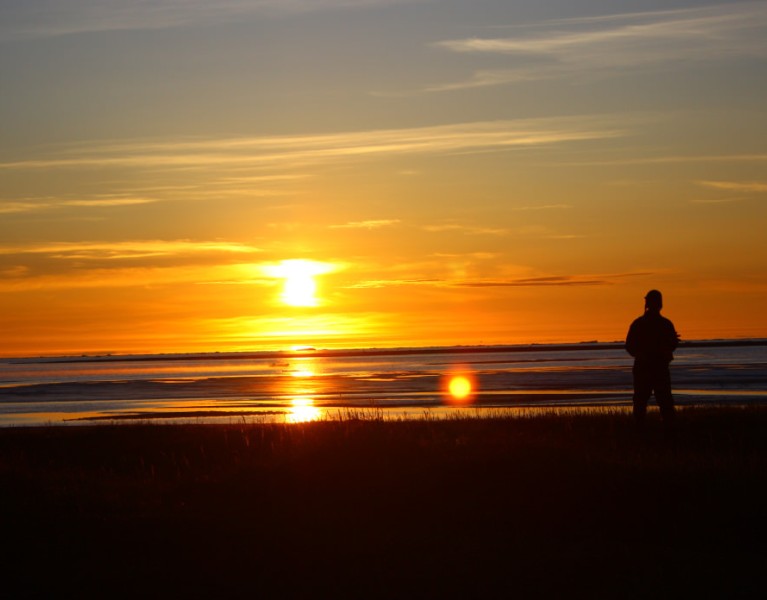
8 Reasons the Arctic National Wildlife Refuge is a Must-Visit Destination (for the Bold at Heart)
Table of Contents [Show]
If you dream of treading untouched wilderness, watching caribou stream across pristine tundra, and viewing polar bears prowling the coast, there's one place on Earth with your name on it: The Arctic National Wildlife Refuge. Although the refuge often makes headlines for the decades-old battle against oil drilling that would disrupt its delicate ecological balance, this 19.2-million-acre wildlife sanctuary is truly remarkable for its immaculate wildness. It is a life-changing, otherworldly experience for the few hundreds of people who are bold enough to visit in any given year. Here are eight reasons why you should be one of them:
1. The Dramatic Landscape

Micah Baird/Sierra Club
The refuge's broad, flat, arctic coastal plain suddenly erupting into the 9,000-foot-tall peaks of the Brooks Range is one of the most majestic displays of geography on the planet. But this is just one of its dramatic landscapes. It's also home to river-carved valleys in the Brooks Range, hundreds of miles of leafy boreal forest, and the windswept coast. Along the rugged beaches polar bears search bone piles left by whalers from the only human settlement in the refuge, the tiny 240-person village of Kaktovik.
2. Endless Sun on the Horizon
From late April to mid-August, the sun never dips below the horizon in the Arctic National Wildlife Refuge. "Where else can you enjoy twenty-four hours of sunshine?" says Michael Wald, co-owner of Arctic Wild. "The lack of darkness means a lack of time constraints. You can hike out over the curving horizon at 2 a.m." When you pair that with seemingly endless wilderness and vistas, Wald says, your imagination becomes one of the few limits to what is possible—and it means the so-called "golden hour" for photographers (when lighting is at its best) seems to go on forever.
3. Hundreds of Thousands of Caribou

Micah Baird/Sierra Club
Nomadic caribou may wander more than 3,000 miles every year in search of food and safety. But there's one place you can count on seeing them. Every spring, nearly 200,000 of them—members of the Porcupine Caribou Herd, the largest herd in Alaska—arrive on the refuge's coastal plains to birth their calves. They will forage until mosquitoes hatch and drive them along the coast and toward the mountains in search of relief, usually in late June or early July.
4. Polar Bears
Bear-viewing is one of Alaska's biggest adventures. It doesn't come any bigger than setting out from Kaktovik to search for polar bears. This is one adventure that you definitely won't want to undertake on your own. Polar bears see humans as potential prey, so it's best to search for them from the comfort and warmth of a secure vehicle, with the company of a guide that knows how to deal with one of the largest land predators in the world.
5. That's Just the Start of the Wildlife

Micah Baird/Sierra Club
Caribou and polar bears may be the most famous animals in the Arctic National Wildlife Refuge, but every summer the refuge teems with wildlife. Muskoxen, wolves, lynx, arctic fox, grizzly bears, and black bears also call this land home, along with some forty species of fish. Snow geese swoop in by the tens of thousands. Roughly two hundred other species of birds migrate here to mate, breed, and raise their young under the midnight sun.
6. True Wilderness Fishing
The mighty rivers that flow out of the Brooks Range to the north hold Dolly Varden trout, grayling, arctic char, arctic cisco, and lake trout. You'll also find grayling south of the mountains, along with burbot, whitefish, northern pike, and several species of salmon. Fishing is allowed year-round, but the waters are only ice-free during the summer.
7. The Challenge and the Space

Micah Baird/Sierra Club
The refuge's remoteness makes even entering the refuge is a thrilling challenge. Your options are to walk in from the Dalton Highway, which is close to the western edge of the refuge, or to take a bush plane into the refuge from the tiny communities of Arctic Village or Kaktovik. Because there are no official checkpoints for entering the refuge, there are no exact visitor numbers. Estimates range between 1,200 and 1,500 people every year. You can easily spend a week or ten days here without encountering another human. Many feel you haven't felt the true power of being alone in nature until you've been surrounded by 19.2 million acres of untouched wilderness.
8. It's a World Apart
At this point, almost every ecosystem on the planet has been touched and changed by man. But the Arctic National Wildlife Refuge, which has quite rightly been described as America's Serengeti, is one of the few intact, undisturbed, ecosystems left. "The refuge is the quintessential exhibit of Earth's perfect biome," says Daniel Oberlatz, owner/guide for Alaska Alpine Adventures. "There are very few places left on our planet where you can immerse yourself in something as captivating. Being able to touch and feel a landscape, and the wildlife within it, along a continuum that is simultaneously both ancient and present. The wilderness of the Arctic National Wildlife Refuge isn't bound to the hands of human time, and is thus completely and perpetually alive."
For more information on what the Sierra Club is doing to protect this national treasure, click here.
Originally written by RootsRated Media for Sierra Club.
Featured image provided by U.S. Department of the Interior/David Payer


